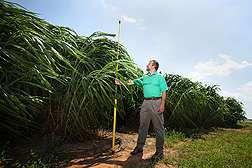Napiergrass: A potential biofuel crop for the sunny Southeast

A grass fed to cattle throughout much of the tropics may become a biofuel crop that helps the nation meet its future energy needs, according to a U.S. Department of Agriculture (USDA) scientist.
Napiergrass (Pennisetum purpureum) is fairly drought-tolerant, grows well on marginal lands, and filters nutrients out of runoff in riparian areas, according to William Anderson, a geneticist in the Agricultural Research Service (ARS) Crop Genetics and Breeding Research Unit in Tifton, Ga. ARS is USDA's principal intramural scientific research agency, and this research supports the USDA priority of developing new sources of bioenergy.
Government mandates call for production of up to 36 billion gallons of biofuel by 2022. While much of that will come from grain ethanol, 21 billion gallons is expected to be derived from other crop-based feedstocks.
As part of a nationwide search for alternatives, Anderson and his colleagues compared napiergrass with several other candidate feedstocks in a study to see how they would fare in head-to-head competition. The researchers grew energy cane, napiergrass, switchgrass and giant reed for four years and compared biomass yields and soil nutrient requirements.
Joseph Knoll, a post-doctoral researcher in Anderson's laboratory, led the research effort. The team included Timothy Strickland and Robert Hubbard, ARS scientists with the agency's Southeast Regional Watershed Research Unit in Tifton, and Ravindra Malik of Albany State University in Albany, Ga.
With sunny skies and long growing seasons, farms and forests in the Southeastern United States are expected to play a major role in providing biofuel crops. The researchers' findings, along with others, show that napiergrass could be a viable biofuel crop in the Southeast's southern tier. It is not as cold-tolerant as switchgrass, but does offer advantages, such as continuing to produce biomass until the first frost.
The researchers are continuing to study napiergrass with an eye toward improving yields, usable fiber content, and disease resistance. They are also evaluating production systems that use chicken litter, synthetic fertilizer, and winter cover crops, as well as different irrigation levels, harvest times and planting dates. Preliminary findings in those studies show yields are sufficient without irrigation, and that there is little difference in yield when poultry litter is used instead of synthetic fertilizers.
More information: Read more about this and other bioenergy research in the September 2012 issue of Agricultural Research magazine. www.ars.usda.gov/is/AR/archive … p12/biofuels0912.htm
Provided by United States Department of Agriculture



















